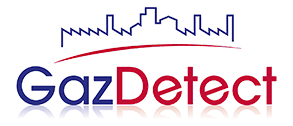Indoor air quality and protective atmosphere measurement
Atmospheric control and measurement cover a wide field of products for a large variety of sectors. These range from measuring the indoor air quality in homes or establishments open to the public (ERP) to controlling the protective atmosphere of food packaging (MAP).
The HTRAM CO2 sensor measures CO2 concentration, humidity and temperature in the ambient air. It continuously analyzes the indoor air quality and the risk of infectious transmission such as COVID-19 by aerosols in shared indoor spaces such as offices, meeting rooms, schools, nurseries, bars, restaurants, waiting rooms, etc.
- CO2, humidity and temperature measurement to identify potential risk of indoor virus transmission such as COVID-19
- Non-dispersive infrared (NDIR) CO2 sensor for accurate monitoring of carbon dioxide levels
- Operating on battery (10 hours autonomy) or continuously (on mains)
- Colored display of the measures: green, yellow and red easily readable
- Ergonomic, compact and easy to use
The CO2 detection light column is used to measure and quantify the presence of carbon dioxide (CO2) in the ambient air. Faced with the coronavirus and its mode of transmission by aerosols, CO2 detection is a very efficient solution to evaluate the presence of aerosol contaminants in a closed space and to proceed to the ventilation of the premises.
- Ideal for public areas (meeting room, restaurant, school, etc.)
- Traffic light-related indications
- Allows measurement of air exchange quality and potentially contagious aerosols
- Pre-calibrated non-dispersive infrared (NDIR) CO2 sensor
- Very easy to install and use
The OXYBABY is a protective atmosphere analyzer for measuring gases in modified atmosphere packaging (MAP). It marks by simple operation, short measuring times, and a small sample volume. The integrated data logger supports traceability and provides comprehensive documentation (HACCP/IFS/ISO).
- Oxygen (O2) and carbon dioxide (CO2) measures in modified atmosphere food packaging (MAP)
- Low gas intake and flow control with alarm if needle clogged
- Storage of the last measurements made for comparison
- Large backlit graphic display with a multilingual menu
- Small cleaning and maintenance costs
Especially designed to detect up to 7 gases simultaneously, the Dräger X-am 8000 multi gas detector is the most powerful and comprehensive in its category for explosive gases (hydrocarbons, solvents, alcohols), toxic or noble gases, and VOCs (volatile organic compounds) detection. We can use it in diffusion mode or gas sampling pump mode.
- Detects up to 7 gases simultaneously with a wide choice of infrared, electrochemical, and PID (photoionization lamp for VOC detection) cells
- Color LCD, simultaneous and continuous display of all gases
- IP67 protection rating (water and dust proof)
- Rechargeable lithium battery - inductive charging
- Approval: ATEX and IECEx, IEC, 2004/108/CE
Indoor air quality analysis
According to the WHO, air pollution kills almost 50,000 people in France every year. Contrary to popular belief, the air inside a home or industrial building can be up to 10 times more polluted than the outside air! Indoor air quality is a real problem and presents significant challenges.
In addition to pollutants brought in from outside, many substances can be released inside premises, notably by building materials (floor and wall coverings, insulation), furnishings (glues, varnishes), combustion appliances, animals, and various human activities (smoking, household products, DIY, etc.).
Devices exist to measure indoor air quality, such as colorimetric reagent tubes for benzene, formaldehyde, or CO2 sensors to measure carbon dioxide released by human exhalation and the induced risk of viral infectious transmission, such as COVID-19. In this field, we can say that Dräger reagent tubes are the best performers for measuring more than 500 gases and vapours.
Measuring carbon dioxide concentration is the simplest way of determining air quality and assessing the quality of ventilation in a room. When the CO2 concentration is too high indoors (over 1000 ppm) the air is not considered healthy. In this case, ventilating the room is necessary (open windows, fan, etc.).
Indoor air quality monitoring is now compulsory in certain establishments open to the public, such as day nurseries, nursery schools, secondary schools, and leisure centers.
Protective Atmosphere Analysis (PAA)
Protective atmosphere packaging involves protecting foodstuffs from contact with air by replacing them with other gases of industrial origin. In practice, this technique is regularly combined with low-temperature preservation. The various gases authorized for modified atmosphere packaging are listed in European Directive 2008/84/EC, the main ones being nitrogen (N2), oxygen (O2), carbon dioxide (CO2), and, more rarely, argon (Ar).
Nitrogen helps preserve dry products, while oxygen protects fresh fruits, vegetables, meat, and fish. Argon is used to pack vulnerable products such as wine. For example, the recommended modified atmosphere for apples is 5% oxygen, 5% carbon dioxide, and 90% nitrogen. The ideal modified atmosphere for red meat retail sales is 70% oxygen and 30% carbon dioxide.
Gas analysis in modified atmosphere packaging involves oxygen and carbon dioxide detection and measurement, with nitrogen as the balanced gas (deduced by difference). Most instruments used to perform these measurements (such as the OXYBABY protective atmosphere analyzer) use a pump sampling system to draw the gas sample through a probe inserted in the package.

